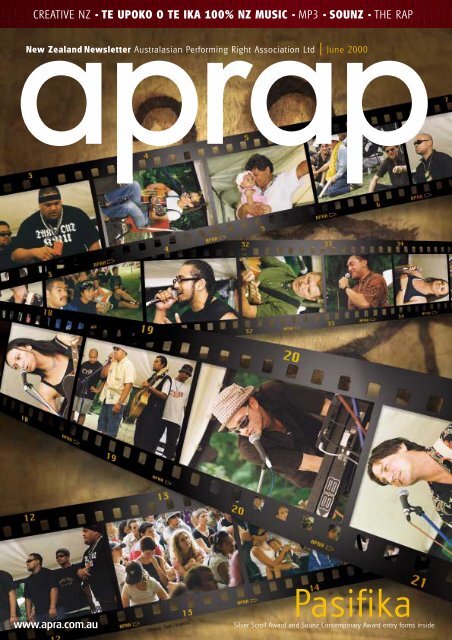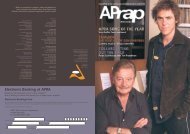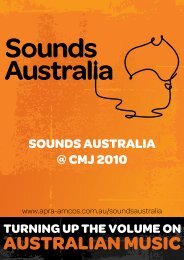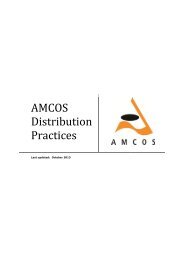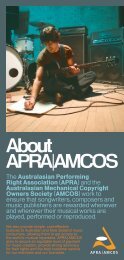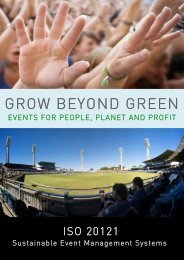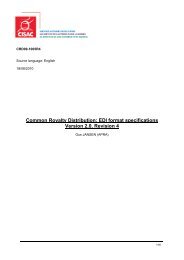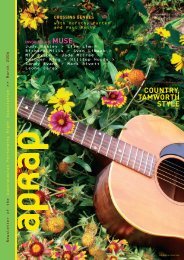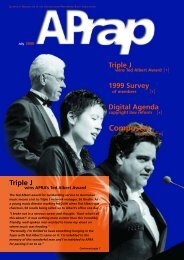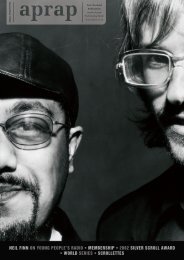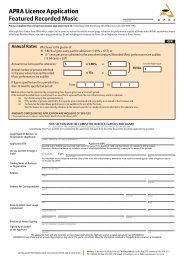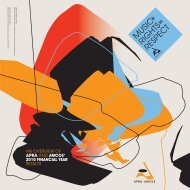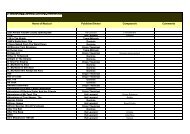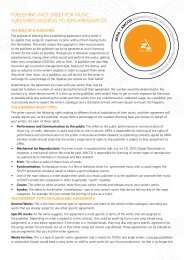You also want an ePaper? Increase the reach of your titles
YUMPU automatically turns print PDFs into web optimized ePapers that Google loves.
CREATIVE NZ • TE UPOKO O TE IKA 100% NZ MUSIC • MP3 • SOUNZ • THE RAP<br />
New Zealand Newsletter Australasian Performing Right Association Ltd June 2000<br />
www.apra.com.au<br />
Photos: Tash Hopkins<br />
<strong>Pasifika</strong><br />
Silver Scroll Award and Sounz Contemporary Award entry forms inside
F R O M T H E<br />
2<br />
Mike Chunn<br />
Director of NZ<br />
Operations<br />
The Music Industry Commission (MIC) is a reality.<br />
Helen Clark announced funding for the MIC at<br />
Parliament Buildings in May as part of an overall<br />
funding boost for the arts, culture and heritage<br />
in New Zealand. The MIC will receive a one-off<br />
payment of $2,000,000 which is to be drawn<br />
down at a maximum $400,000 a year. That’s<br />
a resolute amount of money in my books<br />
although there are murmurings here and there<br />
that it should be more. Whatever - the<br />
contemporary popular music industry has been<br />
acknowledged by a NZ government for the first<br />
time and it is up to the MIC to conceive and<br />
enact projects that will (to quote Helen Clark)<br />
“support the development of NZ contemporary<br />
popular music. It’s objectives will include lifting<br />
the earnings in the industry; and creating greater<br />
exposure and awareness of NZ popular music.”<br />
The Ministry of Culture and Heritage after<br />
consultation with the industry has appointed<br />
a Board of Trustees for the MIC which will run<br />
as a non-profit charitable trust. The board consists<br />
in the main of representatives from major industry<br />
bodies as well as artists and practitioners.<br />
They are:<br />
Mahinarangi Tocker Artist<br />
Dave Dobbyn Artist<br />
Suzanne Wilson b-Net Radio<br />
Liam Ryan Tertiary Education<br />
Arthur Baysting<br />
Board Member<br />
Here Come the Noise Police<br />
Is live music an endangered species?<br />
Increasingly over the past couple of years<br />
we’ve had performers lamenting the closure<br />
of venues and the harassment of others due<br />
to noise control regulations.<br />
One of the difficulties in Auckland is the<br />
recent influx of city apartment dwellers, a<br />
Maria Carter Curriculum Consultant/-<br />
Music teacher<br />
Derek Lowe Radio Broadcasters Assn<br />
Murray Cammick Independent Rec. Labels<br />
Arthur Baysting <strong>APRA</strong><br />
Mike Chunn AMCOS<br />
Terence O’Neill-Joyce Record Industry Assn<br />
Barbara Cuttance Rampage media/pepsismokefreerockquest<br />
The MIC will meet for an inaugural meeting<br />
shortly, from which initial projects will be<br />
formulated. At the same time, it is envisaged<br />
applications will be called for the position of<br />
Executive Director of the MIC. The MIC office will<br />
be based in Auckland.<br />
The one certainty of the MIC is that it will<br />
work on projects in conjunction with other<br />
industry organisations such as NZ On Air and<br />
Creative NZ so that the optimum results are<br />
achieved. As well, the industry will be targeted<br />
as a whole. The projects will encompass the<br />
needs of musicians and writers at all levels.<br />
If any <strong>APRA</strong> members have any input into<br />
how the MIC can benefit the NZ music industry<br />
then feel free to write c/o <strong>APRA</strong> with your<br />
comments. Address the envelope to MIC, Box<br />
6315, Auckland.<br />
In August 1998 I wrote in APrap – “Our industry<br />
is still a flapping bird with its feet on the ground.<br />
When will it fly?”<br />
Helen Clark and her team have just plunged<br />
a syringe of amphetamines in it’s backside.<br />
Watch this space.<br />
Cheers<br />
MIKE CHUNN<br />
few of whom regard the sound of live music<br />
as a reason to pick up the phone and call<br />
in the noise police. One can’t help but wonder<br />
- if it wasn’t for the inner-city vibe - why<br />
they moved there in the first place. Of course<br />
it only takes one call and a club or pub<br />
manager is faced with the choice of turning<br />
down the volume or closing down the venue.<br />
Last month Mike Chunn and I had a<br />
preliminary meeting with Auckland’s mayor<br />
Christine Fletcher and her officials voicing<br />
our concerns. The Mayor emphasised that<br />
she’s keen to establish guidelines so that<br />
everyone’s best interests are served. She<br />
understands the importance of a vibrant<br />
music scene for Auckland and wants to<br />
Australasian Performing Right Association Ltd<br />
An association of composers, authors and publishers of music in<br />
Australia, New Zealand and the South Pacific: Having affiliations with<br />
similarly constituted organisations throughout the world.<br />
Writer Directors:<br />
Arthur Baysting (New Zealand), Jenny Morris, Richard Meale LLB AM<br />
MBE, Michael Perjanik (Chairman), Greg Macainsh, Eric McCusker<br />
Publisher Directors:<br />
Robert Aird Rondor Music (Australia) Pty Ltd, John Anderson EMI Songs<br />
Australia Pty Ltd, Saville Abramowitz Warner/Chappell Music Australia<br />
Pty Ltd, Fifa Riccobono J Albert and Son, Peter Hebbes (Deputy Chairman)<br />
Universal Music Pty Ltd, Ian James Mushroom Music Pty Ltd<br />
Chief Executive:<br />
Brett Cottle LLB<br />
Director of Administration:<br />
Nicholas Hampton FCA<br />
Director of Finance:<br />
Alexander Jeliba FASA Senior<br />
Director of NZ Operations:<br />
Mike Chunn<br />
New Zealand - NZ Head Office<br />
92 Parnell Road, PO Box 6315, Auckland, New Zealand<br />
Telephone: (64) 9 379 0638, Facsimile: (64) 9 379 3205<br />
Membership Email: vhughes@apra.com.au<br />
Internet: http://www.apra.com.au<br />
Wellington<br />
Room 409, Harbour City Centre, Lambton Quay.<br />
PO Box 5528, Wellington<br />
Telephone: (64) 4 499 9151, Facsimile: (64) 4 471 0765<br />
Email: ptogi@apra.co.nz<br />
Registered Office:<br />
Sydney - 6 -12 Atchison Street, St Leonards, NSW Australia,<br />
Telephone: (02) 9935 7900, Facsimile: (02) 9935 7999,<br />
Email: apra@apra.com.au<br />
New Zealand <strong>APRA</strong>P<br />
Auckland, PO Box 6315,<br />
Telephone: (09) 379 0638, Facsimile: (09) 379 3205<br />
Editor:<br />
Debbie Little Email:dlittle@apra.com.au<br />
Finance:<br />
Ray Crofts<br />
Legal:<br />
Anthony Healey<br />
Art Director:<br />
Peter Urlich<br />
Design:<br />
Lorenzo Design<br />
Contributors:<br />
Scilla Askew, Arthur Baysting, Scot Morris, Harris Evans, Peter Urlich,<br />
Anthony Healey, Martin Lodge, Ted Clarke, Petrina Togi<br />
The opinions expressed in articles in <strong>APRA</strong>P are not necessarily those<br />
held by the <strong>APRA</strong> Board.<br />
<strong>APRA</strong>P is produced by The Baton Brigade<br />
© 2000 Australasian Performing Right Association Ltd.<br />
Printed on recycled paper<br />
develop a good environment for music and<br />
live performance.<br />
The Mayor has agreed to convene a<br />
meeting next month with <strong>APRA</strong>, council<br />
officials and security firm representatives<br />
about live venues, noise control, poster<br />
advertising for bands and associated issues.<br />
It would be useful for us, before the<br />
meeting, to have a good idea of what happens<br />
in other parts of the country. If performers<br />
have had good or bad experiences in their<br />
relations with councils and their regulations<br />
we’d like to hear about it.<br />
Please get in touch via fax (09) 379 3205<br />
or e-mail: baysting@voyager.co.nz
Memberstuff<br />
Your Membership Managers<br />
Auckland:<br />
Vanessa Hughes<br />
92 Parnell Road, Auckland<br />
PO Box 6315, Auckland<br />
Ph: (09) 379-0638<br />
Ph: (09) 300-9573<br />
Set Lists vs Live Performance Returns<br />
Set lists are required for promoted concerts as well as some events<br />
and festivals. These shows are licensed separately and the fees<br />
collected by <strong>APRA</strong> are paid out to those works specifically performed.<br />
Do not list these performances on your live performance return.<br />
You must submit a copy of your Set List to the promoter or <strong>APRA</strong>.<br />
The Set List must include the full title and composers of each song<br />
performed. If a member is unsure as to whether or not a set list is<br />
required then please contact us. All other local public performances<br />
should be submitted on your Live Performance Return. These forms<br />
are available from the <strong>APRA</strong> office.<br />
Don’t forget to advise us<br />
when you change address -<br />
no address no cheque!!<br />
Withholding Tax<br />
Payments received from performances overseas usually have<br />
withholding tax deducted from them in the country from which they<br />
were paid. This tax deduction is a tax credit and can be claimed<br />
in your annual tax return. This credit is deductible from your actual<br />
tax to pay. The amounts deducted are listed on your royalty statements<br />
and are identifiable from their inclusion in brackets.<br />
GST<br />
If you are GST registered please send us an invoice for the GST<br />
portion of your royalties.<br />
Attn: Film & Television Composers<br />
Index Cards should accompany Cue Sheets for each audio visual<br />
production for which you have composed music.<br />
Wellington:<br />
Petrina Togi<br />
Room 409, Harbour City Tower<br />
29 Brandon Street, Wellington<br />
PO Box 5528, Wellington<br />
Ph: (04) 499-9151<br />
Dates to Remember<br />
Live Performance Returns (Local/School/Classical)<br />
Submit by 31st July every year<br />
Jingle Forms<br />
Submit by 31st July every year<br />
Overseas Live Performance Returns<br />
No deadline but send in A.S.A.P.<br />
ASCAP Program<br />
14th October<br />
Ambient Music Reporting Form<br />
Submit by end of Feb every year<br />
Register your works online (WebWorks):<br />
You will need your 9 digit CAE number, your 6 digit <strong>APRA</strong> account<br />
number and your surname. You can then check your list of works,<br />
register new works, contact <strong>APRA</strong> etc. New registrations are received<br />
by our head office in Sydney and then processed within two to<br />
three days.<br />
Submit your live performances online:<br />
From June 2000 on, you should be able to complete and submit<br />
your LPR’s online, via our website. We’ve been refining and improving<br />
our existing online LPR service to make it easier and more efficient<br />
for you. As in 1999, the cut-off date for electronic LPR’s will be 31<br />
August 2000.<br />
Want to know if your band name already exists?<br />
For band name registration, legal advice and music industry news<br />
check out the Internet Band Register on www.bandreg.com<br />
www.apra.com.au<br />
3
4<br />
New Weightings for Commercials and Promos<br />
In 1999, the Commercial Music Producers Association (CMPA) asked the<br />
<strong>APRA</strong> Board to increase the weightings it applies to music used in broadcast<br />
commercials and promos.<br />
The rates were reviewed in 1992, however there was no change<br />
to the applicable rate (5% of featured music for TV jingles). The rates<br />
were also previously reviewed in 1989 when the rate for TV jingles<br />
was increased from 2.4% to 5% (of featured music). That rate has stood<br />
ever since.<br />
The Board’s Distribution Committee reviewed the CMPA submissions<br />
and, in September 1999, resolved that with effect from Distribution 37A<br />
(that is, from 1 January 2000):<br />
a) music contained in television station ID’s and programme promos will<br />
receive 15% (increased from 10%) of a full credit for each second of duration.<br />
Once all weightings are taken into account the effective payment is 49%<br />
of an unweighted value.<br />
b) music contained in television advertisements and public service<br />
announcements will receive 7.5% (up from 5%) of a full credit for each<br />
second of duration. Again, once all weightings are taken into account the<br />
effective payment is 24% of an unweighted value.<br />
The Board has also decided to make no change to the weightings for<br />
advertisements, promos and IDs broadcast on radio.<br />
Three more CDs in our SOUNZfine series will be winging their way to<br />
international and NZ broadcasters over the next couple of months. The<br />
CDs which include works by 18 NZ composers and many of our leading<br />
musicians will help to get more NZ music broadcast internationally. The<br />
music ranges from major works by Douglas Lilburn, Eve de Castro-Robinson<br />
and John Psathas to electroacoustic music by David Downes and<br />
performances on Maori instruments by Richard Nunns and Hirini Melbourne.<br />
One of the CDs has a specific focus which particularly demonstrates the<br />
diversity of influences in NZ music.<br />
SOUNZfine is part of a wider strategy to increase international sales<br />
of NZ music. The announcement of new arts funding has given us hope<br />
that other projects to further this will now become reality. While continuing<br />
some of our current education and publication projects we will also be<br />
In the last <strong>APRA</strong>P I wrote about problems in protecting traditional<br />
waiata and on discussions we have been having with Maori on<br />
cultural protection.<br />
In Australia there has been increasing exploitation of traditional<br />
music, for example by sampling of music held in ethno-musicological<br />
collections. A major report has just been completed on indigenous<br />
cultural and intellectual property rights.<br />
The report, Our Culture, Our Future, is funded by ATSIC - the<br />
Aboriginal and Torres Strait Islander Commission - and is based on<br />
extensive research by Terri Janke, principal consultant with legal<br />
In making its decision the Board stated that forming distribution rules<br />
of this kind is not a mathematical task. There is no “correct” or “incorrect”<br />
conclusion; there are only judgements that must be exercised fairly,<br />
reasonably and in good faith.<br />
Sally Howland<br />
Music-use weighting factors from 1 January 2000<br />
Type of music use Weighting<br />
Television (Vocal or instrumental)<br />
Featured 100%<br />
Opening and closing (theme) 75%<br />
Background 50%<br />
Programme promotions, station IDs 15%<br />
Advertisements and public service announcements 7.5%<br />
Radio (Vocal or instrumental)<br />
Featured 100%<br />
Advertisements, station IDs, public service<br />
announcements, stings, bridges, programme promos<br />
and news themes 50%<br />
Making Waves - NZ Music for Broadcast<br />
Protecting Indigenous Culture<br />
working towards new initiatives which we hope will see composer exchanges<br />
with other countries and more residencies in NZ.<br />
Exciting times!<br />
PS If you have heard a work you think deserves to be entered in the<br />
SOUNZ Contemporary Award, then please let us know -<br />
sounz@actrix.gen.nz<br />
Scilla Askew<br />
The Centre for New Zealand Music (trading as SOUNZ) - promoting<br />
New Zealand composers and their music.<br />
PO Box 10042, Level 1 39 Cambridge Terrace, Wellington<br />
Tel: 04 801 8602, Fax: 04 801 8604<br />
Email: sounz@actrix.gen.nz Website: www.sounz.org.nz<br />
firm Michael Frankel & Co.<br />
Ms Janke met with indigenous people, government departments,<br />
industry organisations and other interested individuals concerned<br />
about the appropriation of traditional culture through commercialism,<br />
new technology and globalisation.<br />
The report contains several recommendations which the music,<br />
recording, film and entertainment industry is encouraged to read<br />
and adopt in their day-to-day practice. The full report can be accessed<br />
on the net at www.icip.lawnet.com.au<br />
A.B.
Photo: Petrina Togi<br />
<strong>APRA</strong> Says Farewell to Donna White<br />
Left to Right: Claire Rodgers & Jennie<br />
Allen from RIANZ, Donna White<br />
Donna White has been the <strong>APRA</strong> NZ<br />
branch finance manager since the office<br />
moved to Auckland in July 1992. Donna<br />
was in the accounts division of Sony<br />
Music when I was working there in what<br />
is now known as Malcolm Black’s job.<br />
Donna was impressive in her<br />
communication and persuasion skills<br />
and I knew she was the one for <strong>APRA</strong>. Over a beer at the Cavalier pub I<br />
asked her to join me as my first team member. She had no idea how<br />
<strong>APRA</strong> worked or what her job entailed but then neither did I so we just<br />
got into our trunks and dived into the deep end of the pool.<br />
Over the next eight years, Donna played a crucial role in establishing<br />
The union of the www and MP3 technology has opened the gate<br />
for music writers… a gateway to a virtual market place never before<br />
imagined.<br />
But is it the nirvana that it seems? Is your music safe out there<br />
in digital-world? What is MP3? Is it the answer? And most importantly<br />
who will hear my music and will I get anything in return?<br />
MP3 is a digital recording format that delivers near CD-quality<br />
sound and unlimited copies without degradation. The software to<br />
convert music into MP3 files is freely available on the net to the<br />
extent that “MP3” is the most searched phrase on the Internet. Once<br />
converted an MP3 file can be sent to friends, played back on a<br />
computer, a portable MP3 player or converted to CD.<br />
MP3 web sites have emerged offering unsigned artists, often free<br />
of charge, the facility to include their work on the web site. Browsers<br />
to the site then chose to listen to or download individual songs or<br />
albums. Any charge to the consumer that downloads the song should<br />
be split between the artist and the site owner.<br />
In the US MP3.com was launched as a simple directory and news<br />
service for the nascent MP3 community in the States. It evolved<br />
into the world’s largest download site (boasting more than 500,000<br />
users a day) where unsigned bands can promote and distribute their<br />
music online.<br />
<strong>APRA</strong> member Alan Brown and his band Mistake Theory featured<br />
on MP3.com’s web site front-page artist spotlight last year resulting<br />
in some 843 downloads of their song “Shallow” in just a 2 day<br />
period.<br />
In New Zealand, MP3.net.nz want to deliver NZ’s first<br />
comprehensive NZ music website, acting as a virtual interactive<br />
broadcaster and music distributor. As entertainment lawyer and<br />
founder of MP3.net.nz Chris Hoquard says, “the quality of NZ music<br />
has never been better. Many bands don’t have an option – if people<br />
want to search out NZ music then we can be a focal point for this<br />
interest and represent a wider spectrum than ever.”<br />
“On our site the artist retains control and ownership of their<br />
music. They simply licence it to us non-exclusively to distribute<br />
and sell it. Anyone is able to enter the site, read about or listen to<br />
an artist’s work and then download or purchase the direct mail CD.<br />
We share the proceeds 50/50. It’s just another tool in the artists<br />
promotional arsenal.”<br />
the accounting and IT systems that are so crucial<br />
to the running of the NZ branch. Her extraordinary<br />
talent for assimilating billions of bytes of<br />
information; her ability to focus on problems<br />
in microseconds and tackle them with aplomb;<br />
her pride in her work and her fantastic results<br />
all made her a valuable, wonderful person<br />
to work with.<br />
And now Donna is on Norfolk Island fishing and shooting the breeze.<br />
Farewell, Donna. Many thanks.<br />
Mike Chunn<br />
<strong>APRA</strong> would like to take this opportunity to welcome Ray Crofts to the<br />
Finance Management chair with Isobel Martinez as Finance Assistant.<br />
MP3: Music for the Masses or Just Masses of Music?<br />
There’s no doubting the benefit of the web to music writers. The<br />
market it creates is huge. So if an audience can find its way through<br />
the plethora of music sites crowding the web, what are the risks?<br />
Ian James, Managing Director of Mushroom Music and long time<br />
director of <strong>APRA</strong>, agrees that the technology is amazing, but advises<br />
caution.<br />
“My main concerns are the renegade nature of the Net and the<br />
way that MP3 technology plays right into these hands. There’s a<br />
web mindset that the net is free, copyable, and downloadable. No<br />
one should have to pay for it…”<br />
Currently <strong>APRA</strong> is negotiating licence arrangements for the<br />
transmission and reproduction of musical works (on behalf of<br />
AMCOS) with most of the major websites in NZ that have a music<br />
presence.<br />
Before you make your music available to a website think about:<br />
• The agreement – does it ask for your entire copyright? If you<br />
already have a record deal or publishing agreement or if you are<br />
a member of <strong>APRA</strong> you may have already assigned certain rights<br />
to a record company, publisher or <strong>APRA</strong>. If that’s the case then<br />
you can’t assign all your rights to someone else.<br />
• The security – check that the site has secure mechanisms in place<br />
to either prevent downloads or to prevent further copies being<br />
made of the original download. Or just provide a 30 second clip<br />
of your work – not the whole song. If copying doesn’t bother<br />
you, don’t worry.<br />
• The money – is there an agreement to pay you for the number<br />
of downloads made of your work? Will it make money for you<br />
or just create advertising revenue for the site? Is it possible for<br />
the site to track downloads of your music and does the site have<br />
an <strong>APRA</strong> or AMCOS licence to copy and transmit your work to<br />
the public?<br />
• The exposure – what will the site do to promote your work? Is<br />
it easy to find? The net is still considered most effective when<br />
used in conjunction with traditional promotional materials i.e.<br />
playing live, recording demos, and record companies all still<br />
form part of the equation.<br />
• The out clause – how easy is it to change your mind and get off<br />
the site? Will it cost you? Will leaving effect your rights?<br />
Anthony Healey<br />
5
Photo: Mike Clinton<br />
William Dart<br />
6<br />
Noodles & Spaghetti William Dart by Martin Lodge<br />
Irreverent polymath? Workaholic? Grey eminence of NZ music? William<br />
Dart is all that and more. Music commentator, editor, reviewer, composer,<br />
performer, broadcaster, panelist/consultant, collector, traveller, full-time<br />
university lecturer — William doesn’t sleep much.<br />
He has a breadth and depth of knowledge of NZ music that is unparalleled.<br />
He moves readily between different fields of music, revealing a genuine<br />
appreciation and love for an amazing variety of genres, styles and eras.<br />
On his desk as I talk with him there are CDs of Norwegian jazz singer Karin<br />
Krog, an album of various orchestrations of Schubert Lieder and the new<br />
Wendy Carlos collection of Bach electronica. ‘On the question of moving<br />
between popular and classical areas of music, I just think of noodles and<br />
spaghetti’ he says. ‘Essentially the same but<br />
called different names according to the cultural<br />
background of the user. The Chinese call it<br />
noodles, the Italians call it spaghetti — it’s the<br />
same food. And so with music, but we might<br />
shift on to a four lane highway, to change<br />
metaphors. Classical, rock, jazz . . . the musicians<br />
are all travelling towards the same “destination”<br />
which is communicating with the listener.<br />
They just approach the goal from different<br />
perspectives’.<br />
Talk to William about music for more than<br />
five minutes and he’ll start effusing about the<br />
art of songwriting: ‘The three-minute song<br />
form is a fantastically demanding discipline,<br />
from Dowland to Chris Knox. And Chris’s new<br />
album, Beat, has some of the sharpest songwriting that I’ve heard this<br />
year. And it’s an album with a sting in its tail, which many critics rather<br />
overlooked. After Chris has sung the final number listed — the nearest he’ll<br />
ever get to a Tudor lutesong — you have to hang in for a few minutes<br />
silence and then there’s another stack of songs’.<br />
The nearest William comes to ranting is when you turn the subject to<br />
critics. William made his name writing concert reviews for the Listener and<br />
talking about rock and other contemporary music on the then Concert<br />
Programme back in the late 70s, ‘with the Sex Pistols snuggling up to<br />
Mozart and Haydn, so to speak’. He’s always felt a special engagement<br />
with the music happening in this country. ‘Quota or no quota, I’ve always<br />
ensured that New Horizons has at least a 30-40% local quota and it’s<br />
been great creating interview-based documentaries with musicians like<br />
Mahinarangi Tocker, Dave Dobbyn, Chris Knox, Matthew Bannister and<br />
Bryce Galloway. Last year, when Concert FM commissioned me to make<br />
a two-hour documentary about New Zealand music in the 90s, I rifled<br />
back amongst my old interview tapes and found some illuminating gems.’<br />
‘Perhaps I’m a little naive, but I cannot imagine why we don’t support<br />
New Zealand music more fervently. Firstly, it’s being created by artists and<br />
musicians who are trying to survive in this country; secondly, it’s music<br />
that talks to us about issues that directly concern us in New Zealand. We<br />
made an awful gaffe years ago by playing Sibelius at Expo 70. And did<br />
we really have to celebrate our America’s Cup victory with Australian music?’<br />
William feels strongly that critics are not doing what they should do.<br />
‘I simply can’t imagine why a critic would want to live in this country and<br />
to ignore its culture. How could one local reviewer write up two concerts<br />
by the Auckland Philharmonia, enthuse about Mahler and Bruckner, and<br />
totally ignore a 20-minute work by a New Zealand composer which was<br />
on one of the programmes?’ And composers are chided too: ‘The Composers<br />
Association needs far more visibility. It was great to see Gillian Whitehead,<br />
Helen Bowater and Brigid Ursula Bisley up at the <strong>APRA</strong> Music Awards last<br />
year alongside the Neil Finns and the like, but there needs to be a noisy<br />
and well orchestrated campaign against anything that overlooks the New<br />
Zealand composer’. Some years ago, incensed by Kiri Te Kanawa’s dismissal<br />
of our music as ‘a few little Maori songs’, William gathered together six<br />
pages of rebuffs from local composers and musicians and published them<br />
in Music in New Zealand.<br />
It was William’s involvement with Art New Zealand which he has edited<br />
since 1982 that inspired him to produce Music in New Zealand, a quality<br />
journal that is not afraid to have Greg Malcolm and Moana rubbing shoulders<br />
with Douglas Lilburn and the Kiwi Concert Party. ‘I could see what Art New<br />
Zealand was doing in terms of affirming that our country had all this<br />
marvellous art and realised that the same thing needed to be done for<br />
our music’.<br />
William is just back from Sydney, where he was a keynote speaker at<br />
the recent Australian and New Zealand Musicological Society Conference,<br />
sharing the platform with Americans Susan McClary and Rob Walser, author<br />
of the 1993 classic Running with the Devil: Power, Gender and Madness<br />
in Heavy Metal Music. William’s paper, entitled “Our Song: Towards a Kiwi<br />
Vernacular” pointed out that ‘there is a real connection, spiritual and musical<br />
between Douglas Lilburn’s Sings Harry and the songs of Dave Dobbyn.<br />
Now all we need is for someone to get Dave to record it and give it the<br />
immediacy that it cries out for’.<br />
William hit his half century a couple of years ago, but vividly remembers<br />
his childhood in Whakatane: ‘I was an eccentric child and a little on the<br />
solitary side, making a life out of music, roller-skating and quite manic<br />
collecting. The skates are now under the bed, although William still<br />
occasionally dons his Waikato rep blazer; and these days the collecting<br />
from Santa Claus songs and classic peanut butter glasses (William’s<br />
collection has starred in Peter Wells’ film Little Queen and inspired Peter<br />
Peryer to take one of his most celebrated images of the 80s) to CDs,<br />
especially in those $5 bins ‘where you make the most extraordinary finds’.<br />
‘Whakatane was wild macho territory in the early 60s, with compulsory<br />
military drill for boys, and a small-town seediness halfway between In the<br />
Heat of the Night and Harper Valley. And it was there I had a heaven-sent<br />
piano teacher, Violet Rucroft, who had come back from the Royal Academy<br />
and set up a music studio in town with pianos and equipment ranging<br />
from Varese 78s to some Dolmetsch virginals. Ru was a Forest and Bird<br />
fanatic, dividing her passion between weeding the Urewera and grilling<br />
us on our Mozart sonatas. The pukekos and many Whakatane youngsters<br />
reaped the benefit’.<br />
William ended up in the classrooms of Edgewater College in the 70s<br />
and 80s, and his students were fed a diet of VarËse and Van Dyke Parks,<br />
his students staging suites from Marat-Sade for chamber music concerts<br />
and enlivening prizegivings with Walton’s FaÁade and discreet raunch<br />
from Kurt Weill. During his final two years at the chalkface, he toured with<br />
two shows he had — Songs to the Judges, co-written with Mervyn Thompson,<br />
and Give Us a Kiss, a gay review, put together with John Curry, both toured<br />
by the Students Arts Council.<br />
Since 1998 William has been lecturing full-time in the Music Department<br />
at the University of Waikato where he enjoys sharing his expertise in New<br />
Zealand music, and popular music studies from the history of rock through<br />
to Broadway musicals. He is also in demand as a graduate supervisor of<br />
theses, yet manages to keep making the radio shows, edit the magazines,<br />
perform…. Sleep is still a rare luxury.
International Update<br />
<strong>APRA</strong> is closely monitoring and is an active participant in some<br />
international e-commerce projects. Here’s a snapshot of the major<br />
projects and what they hope to deliver.<br />
International Music Joint Venture (IMJV)<br />
In November 1999, ASCAP (the American Society of Composers,<br />
Authors and Performers), BUMA–STEMRA (the Dutch society) and<br />
MCPS-PRS (UK), formed the IMJV Company to develop a shared<br />
service centre – a one stop data shop – to help them increase their<br />
efficiency and reduce costs.<br />
The societies plan to offer IMJV’s shared back office services to<br />
music societies across the world. IMJV will not have creator or<br />
publisher members, it will simply use one system to process<br />
international music transactions, such as:<br />
• keeping track of new works and agreements<br />
• tracking performances on television<br />
• tracking radio and public performances<br />
• handling mechanical rights sales transactions.<br />
Societies who want to use IMJV’s system will pay a set transaction<br />
fee. Although information will be shared, each society will still<br />
maintain its separate cultural integrity and independence.<br />
IMJV is now consulting with collecting societies and music publishers<br />
around the world to assess its business model, its impact on publishers,<br />
resolve business issues and review its proposed copyright management<br />
system design. The plan is to start building the system in 2000 and<br />
to go live in the second half of 2001.<br />
<strong>APRA</strong>/AMCOS is monitoring IMJV’s progress and its impact on<br />
the established CISAC Common Information System (see below). We<br />
will consider becoming involved with IMJV at a later stage, if it will<br />
prove to be beneficial.<br />
Common Information System (CIS)<br />
CIS is a collaboration by CISAC societies to develop standard systems<br />
for copyright documentation and royalty exchange between copyright<br />
societies around the world. Some documentation tools have already<br />
been developed are or being developed. CIS is now clarifying key<br />
legal, financial and technical points relating to these subsystems.<br />
Senior executives at <strong>APRA</strong> have participated in the development<br />
of some of these subsystems.<br />
Protonet<br />
Protonet is an web-based search engine that will allow other societies<br />
to make online queries about foreign repertoire and also help to<br />
resolve conflicts. It is being developed by BMI and ASCAP (USA),<br />
SACEM (France), SGAE (Spain) and SIAE (Italy) with CISAC as an<br />
observer. Both the IMJV and CIS plan to use Protonet as an additional<br />
tool to achieve their aims.<br />
<br />
is an international collaborative project, supported by<br />
the European Commission, that is developing standards and service<br />
specifications to support e-commerce in intellectual property in all<br />
sectors of the content industry, not just music. It is working with<br />
the various other e-commerce metadata models, such as SDMI, CIS<br />
and DOI. The Copyright Agency Ltd (CAL) and <strong>APRA</strong> will be cohosting<br />
the first meeting to be held in this part of the<br />
world later this year.<br />
DAWN 2001<br />
The Japanese society, JASRAC, is developing DAWN 2001 (“Designs<br />
for the Administration of Works using New technology”). DAWN<br />
will provide systems for tracking internet and satellite transmissions<br />
by using tools such as electronic watermarks, electronic billing<br />
systems, copy protection, secure distribution channels, electronic<br />
authentication and electronic usage reports. JASRAC hopes that<br />
DAWN will monitor and prevent illegal usage, ensure fast and<br />
accurate distribution for all music uses and be compatible with CIS<br />
and other international projects. JASRAC is currently establishing<br />
a consortium with internet content distributors and neighbouring<br />
rights owners (broadcasters, record companies and film and multimedia<br />
producers).<br />
Horizon Project<br />
BMI (US) is promoting its system enhancements which allow online<br />
works registration for songwriters, composers and publishers,<br />
electronic payment and royalty information, electronic cue sheet<br />
registration by film and TV producers, watermarking digital reporting<br />
by broadcasters, online licence fee payment and a new release of<br />
their web search engine named BMIMusicBot.<br />
SongFile is the initiative of the Harry Fox Agency (HFA) and the<br />
National Music Publishers Association in the US. It is a website<br />
which aggregates several sites, including a large database of song<br />
lyrics, a site listing retailers of sheet music, recordings, instruments<br />
and concert information. It also has links directly to HFA, ASCAP<br />
and BMI for licensing information and to other significant music<br />
sites on the web. The site is reputed to have more than a million<br />
visitors a month. You can visit SongFile at www.songfile.com.<br />
by Scot Morris, <strong>APRA</strong> Director of International Relations<br />
“We will begin with Schubert’s ‘Unfinished’ Symphony, and that will<br />
be followed by Beethoven’s ‘Unwanted Sexual’ Overture.”<br />
New Yorker<br />
7
8<br />
Graeme Nesbitt 1950 – 2000<br />
Graeme Nesbitt, 1970<br />
Graeme Nesbitt; promoter, performer and<br />
professional party animal, died on May 17<br />
of cancer at his home in Malaysia. He was<br />
50 years old.<br />
A seminal figure in NZ rock history, Nesbitt<br />
was our first “hippie entrepreneur” as a<br />
promoter and manager. Sporting a Che<br />
Guevara look – beard and beret – Nesbitt<br />
formed the Victoria University Rock-Blues<br />
Society and embarked on a series of concerts<br />
Mike Farrell 1948 – 2000<br />
People play catch with the term legend. One dictionary definition reads<br />
“An unverifiable story handed down by tradition from earlier times and<br />
popularly accepted as historical”. Much of Mike’s life is verifiable but a<br />
whole lot will be etched in the mythology of the bars, clubs, recording<br />
studios and roadside tearooms of New Zealand. By any definition we lost<br />
a true kiwi music legend in the early hours of Saturday 20th of May. Today<br />
we laid Michael John Farrell to rest.<br />
Many people throughout New Zealand have been privileged to hear<br />
Mike’s recorded work and maybe were blessed enough to experience<br />
him live and shining brightly. Many more though know the name Mike<br />
Farrell from word of mouth. Tales tall and occasionally true regarding this<br />
enigmatic genius flew thick and fast. Everyone had their own take on<br />
this fiery Irish son, and Mike kinda liked it that way.<br />
Educated at Mana College in Titahi Bay, Wellington Mike came under the<br />
early influence of music teacher, Louis Fox (father of big band leader<br />
Rodger Fox). Louis actively encouraged the young guitar player’s interest<br />
in music styles that extended beyond the di-rigeur pap of the mid 60’s.<br />
Mike was soon performing with his first band Fantasy and other local<br />
acts on the Wellington scene.<br />
Through bands such as The Bitter End, Rebirth and Tom Thumb Mike’s<br />
reputation spread. He became the first bona fide guitar hero in Wellington<br />
during the late 1960’s. Friend and fellow musician Neil Hannan recalls<br />
a piece of graffiti at the time that ran “If Clapton is God then Mike Farrell<br />
is number 2”. He went on to play with seminal NZ bands like Rough<br />
justice with Rick Bryant and Country Flyers with Blues icon Midge Marsden,<br />
the beginning of a long and productive personal and professional association<br />
with Midge. Their artistic culmination was the classic Burning Rain. Mike<br />
composed that song as well as Little Ray, Elle and co wrote Struck Down<br />
by the Blues and Nadine. Mike received a gold record for his contribution<br />
to the album and a Silver Scroll nomination for Burning Rain.<br />
Mike’s guitar expertise found him gracing the stage with such diverse<br />
performers as Stevie ray Vaughan, Champion Jack Dupree, Jimmy Witherspoon,<br />
Wilco Johnson (Dr Feelgood), Jerry Harrison (Talking Heads) and Glen<br />
Shorrock (Little River Band) and on the local front the Backdoor Blues<br />
Band and NZ Blues Brothers Revue. He was often spoken of as a great<br />
blues guitarist, and he was. He was a fine electric and acoustic blues<br />
player and vocalist. However he was just so much more. He could turn<br />
his attention to many genres of music and still shine. His own music<br />
reflected the diverse influences that had shaped him. Country, rock, pop<br />
urban and country blues were filtered through that wonderful Celtic soul<br />
described in Dix’s “Stranded in Paradise” as the capital’s “first true<br />
psychedelic shows”. He then organised the first university Students<br />
Arts Festivals and went on to manage bands like Mammal, The Red<br />
Hot Peppers, the Wide-Mouth Frogs and Dragon. As a promoter he<br />
toured folkie Phil Ochs and ska act Little Millie Small and as a performer<br />
he reached the finals of Studio One in the trio Country Deal.<br />
Nesbitt’s wife, mother and sister were at his bedside when he<br />
moved on.<br />
A.B.<br />
of his. Most of all he was a songwriter with a rare gift for melody, harmony<br />
and lyrical honesty.<br />
On a personal note Mike and I had just had just finished an album<br />
called Wildlife, created over the last two years in between paying the bills<br />
and painting the house. I am so sad that he never got to see its release.<br />
His work both as a producer and musician was outstanding and I had<br />
high hopes that it would see Mike get the widespread recognition I have<br />
always felt was his due. With Mike’s passing I now realise that it’s the<br />
songs that we wrote together that were such a gift, such a revelation. He<br />
gave a musical voice to my words and feelings that may never have seen<br />
the light of day. He unlocked doors for me and taught me the importance<br />
of finding truth in your work. Mike was a passionate man and a passionate<br />
artist and he knew that you must make the things you do in life count,<br />
there was no second best. He did the same for so many people over the<br />
years and that is another part of his legacy.<br />
Mike said in a Herald interview ten years ago “you know I think after<br />
all these years, I’m still getting better - just getting closer all the time”. He<br />
was right. He did get better, he did get closer, but he had come to know<br />
that it wasn’t about a destination, it was a journey. It’s a journey that will<br />
continue because he gave so much.<br />
At the funeral service, Midge Marsden spoke of that fearsome Farrelli<br />
talent, “he was the musical Godfather”, that look that he gave on stage<br />
(in some quarters known as the hairy eyeball) when things didn’t go right<br />
or someone hit a bum note. If that look could make hell freeze over, the<br />
smile you got when you did something cool would make it melt again.<br />
A piece by Jean Cocteau filtered through the spirit of Django Rheinhart<br />
and long time friend Mathurin Molgat captured the essence of Mike and<br />
was used as part of the service:<br />
Michael Gone: He was one of the humble, the proud.<br />
He lived as we dream of living in contentment and harmony.<br />
His peace was contagious and infectious, his spirit vagabond.<br />
His rhythms were his, like a tigers stripes,<br />
Like his laugh, the look in his eye. They make him<br />
invisible to a world that wanted mediocrity, conformity.<br />
Liam Ryan summed it up for all when he addressed Mike’s kids and<br />
said you can say your dad was a legend, a true legend. He turned to<br />
Mike and encapsulated his life with the words “That’s a take”, everybody<br />
in the house understood.<br />
Ted Clarke
“Show Me the Money”<br />
Jeremy Winter is the Arts Advisor for the<br />
Music Arts Development program at Creative<br />
New Zealand. CNZ have done very well from<br />
the Coalition Government’s cultural funding<br />
announcement. In response to queries from<br />
our membership, we put Jeremy on the spot.<br />
Q: How does Creative New Zealand run?<br />
Jeremy Winter<br />
CNZ runs two funding rounds per year with<br />
closing dates late February and late July. The decision-making<br />
process takes three months from the closing date and we don’t fund<br />
retrospectively (ie no grants for money already spent on a project).<br />
Funding Guides and application forms are available from our three<br />
offices in Auckland, Wellington and Christchurch and arts advisers<br />
are happy to answer any questions after a prospective applicant<br />
has firstly read the guide.<br />
Q: How did Creative New Zealand come into being and what is its<br />
brief regarding New Zealand music?<br />
Creative New Zealand is the trading name for “The Arts Council of<br />
NZ, Toi Aotearoa” which came into being with legislation passed<br />
in 1994. In a number of ways this Act gives CNZ a wider brief than<br />
the former QEII Arts Council with responsibility “to encourage,<br />
promote and support the arts for the benefit of all New Zealanders”.<br />
One of the major ways we do this is through giving grants but there<br />
is also an important communication and advocacy role. At present<br />
most of our funding comes from the Lottery Grants Board ( $20M<br />
per year) with under $3M through Vote:Culture. Grant decisions<br />
are made after seeking advice from external specialist assessors,<br />
by two arts boards and a committee for Pacific Island arts. A<br />
significant proportion of the funds available supports established<br />
infrastructure arts organisations such as theatre companies and<br />
regional orchestras. About $5,000,000 per year is currently available<br />
for “Project funding” to individual artists and to project-based arts<br />
companies. The money has to cover all art forms (theatre, visual<br />
arts, literature, moving image, dance, music etc.).<br />
Q: Who are the Musicians you’re trying to reach?<br />
Project funding for musicians is targeted at the range of genres<br />
(classical, experimental, jazz, pop/hiphop etc.) with a priority on<br />
creating, developing and presenting original innovative and high<br />
quality NZ music. Within each funding round we try to support<br />
experienced and emerging artists. Given limited funds one of the<br />
main questions the Board asks is “will a grant at this time make a<br />
difference to whether or not this worthwhile project goes ahead<br />
(will it be a catalyst?) and what is the future potential (is it strategic?)”.<br />
Evidence of some previous success/commitment and the support<br />
of other parties (e.g. record company investment to cover CD<br />
manufacturing and distribution) gives confidence. An upper limit<br />
for a debut CD would be about $5,000 but, depending on the project<br />
and the artists, many grants are much larger than this.<br />
Q: What specific programmes do you offer?<br />
We have three funding programmes that are the same for all art<br />
forms: New Work (which is generally where a musician would apply<br />
to write and/or record previously unreleased material), Creative<br />
and Professional Development (might involve research,<br />
workshops/courses, mentoring) and Presentation, Promotion and<br />
Audience Development (such as concert tours in NZ and overseas).<br />
There are no set amounts put aside for each art form or each type<br />
of application - everything competes with everything else, but to<br />
give you a general idea $150,000 - $200,000 has gone to<br />
contemporary pop/rock/jazz projects each year.<br />
Q: How many people apply and how many people are successful?<br />
In the current round we have 200 applications for music project<br />
funding. About 50 are likely to be successful. The fact that we run<br />
out of money is heartbreaking - because as a rule another 50<br />
applications would deserve support each time.<br />
Q: What makes a good application?<br />
One of the main funding criteria is artistic excellence and quality<br />
support material including CD/cassette demos is essential (We are<br />
now asking for 5 copies so that all applicants get a fair hearing<br />
from all the assessors), Also required is a clear description of what<br />
the project will achieve and how it will happen; how it fits the<br />
priorities for the CNZ Funding Programme; and a reasonably detailed<br />
budget showing all anticipated costs (including musicians fees -<br />
often overlooked) and anticipated sources of income. Often the<br />
budgeted deficit (say after a year’s CD sales) will equal the size of<br />
grant requested. It is a not helpful to inflate the ‘ask’ with extravagant<br />
studio hire rates. Considering the huge number of applications to<br />
read and analyse we don’t want to have to wade through an<br />
autobiography and a thesis on the ‘philosophy of art’ in order to<br />
find the ‘guts’ of the application buried towards the end.<br />
Q: What is the situation with Te Waka Toi?<br />
Te Waka Toi is one of the two boards under the umbrella of the<br />
Arts Council. It currently has about $1,000,000 per annum to allocate<br />
and a number of its grants are supporting music and performing<br />
arts activities. In general TWT limits itself to projects “by Maori<br />
(artists) and for Maori (audiences)” so a lot of artists who<br />
identify themselves as Tangata Whenua apply to the Arts Board<br />
instead, because they are creating and presenting for the general<br />
public. There is also the Pacific Islands Arts Committee which<br />
operates along similar lines and allocates about $300,000 in grants<br />
per annum.<br />
Thanks very much Jeremy, you have been very helpful.<br />
A.B.<br />
Contact: www.creativenz.govt.nz<br />
“A lot of you used to know us as the L.A. Punksters.<br />
Then for a while we were the Rappin’ Rapmen. Now<br />
we call ourselves Los Latinos del Momento.”<br />
New Yorker<br />
9
10<br />
THE RAP<br />
At last, I hear you say, some decent reading!<br />
Life can’t be all facts and figures so here’s<br />
another delicious slice of industry tittle tattle,<br />
straight from the horse’s mouth.<br />
New Zealand’s favourite covers band are in<br />
shock. Yes, the mercurial HitList (formerly<br />
known as The Peter Stuyvesant Hit List before<br />
smoking became passe,) was hit with a<br />
bombshell recently when ’Wild’ Chris<br />
Anderton decided to pursue a new career<br />
in catering, leaving the rest of the band<br />
without a frontman and sex symbol. Bass<br />
player, Sweet Baby Dave will, evidently, be<br />
reluctantly filling the gap.<br />
Looking across the Tasman, there are obvious<br />
comparisons being made between our lovely<br />
lasses, TrueBliss and their Australian<br />
counterparts, Bardot. The Rap held an<br />
informal poll at the weekly after-works<br />
drinkypoos and the result was an<br />
overwhelming vote of confidence for our<br />
local girls who it seems, have stronger voices<br />
and more personality even if only on a<br />
quarter of the budget. Meanwhile, it’s<br />
rumoured that the “Blisster’s” Carly, “Not<br />
Those Shoes” Binding, has been furiously<br />
penning possible songs for a new album.<br />
Speaking of good looking girls, the rather<br />
disturbing photograph above was stuck<br />
under the door of The Rap offices the other<br />
day by unknown persons who obviously<br />
have more than a passing acquaintance<br />
with the two ‘individuals’ pictured. An<br />
accompanying note informed us that unless<br />
the subjects of the photo made a decent<br />
donation to the SPCA immediately, then their<br />
identities would be revealed to the media,<br />
promising careers in Music Publishing would<br />
be seriously threatened and certain wives<br />
and girlfriends would be “off to Mother’s”<br />
until some serious explanations had been<br />
provided. Always able to see the lighter side<br />
of things, The Rap has decided to invite our<br />
readers to offer their ideas on the dynamic<br />
duo’s identity and the first correct entry will<br />
receive an autographed copy of Poison. Clue;<br />
they ain’t The Proclaimers!<br />
Latest musical export doing well is that<br />
charming and well-mannered <strong>APRA</strong> member,<br />
Mark de Clive-Lowe whose sparkling new<br />
album, 6 Degrees, gained a European release<br />
via the Universal Jazz label and is receiving<br />
glowing reviews in London. One scribe from<br />
a trendy magazine called DJ Mag was moved<br />
to write, “..if this is the future, give me more.”<br />
All sounds rather flash! Let’s hope the young<br />
man doesn’t forget his roots.<br />
And as the nation’s commercial radio<br />
networks kafiddle and kafuddle over support<br />
of indigenous music, Auckland’s 95 bFM<br />
can wallow in the unbridled success of their<br />
recent New Zealand Music week. How<br />
extraordinarily good it was to hear all those<br />
fine tunes and know that they all came from<br />
our own backyard. The live-to-air’s were<br />
particularly inspiring and The Rap would like<br />
to take it’s hat off to bFM but we’re having<br />
a bit of a bad hair day, Luv.<br />
On the subject of hair, songsmith and chef,<br />
Greg Johnson threw a very stylish soiree in<br />
honour of the release of his latest CD, The<br />
Sea Breeze Motel. No ordinary old club or<br />
bar for Mr Johnson’s launch but only the<br />
fabulous Concert Chamber of the Town Hall,<br />
dolled up and decked out to enhance the<br />
theme, including jugs and jugs of the<br />
infamous cocktail of the same name. Well<br />
talk about kiddies in a toy shop – the gathered<br />
horde of media-types and ‘celebs’ didn’t have<br />
to be asked twice to start drinking and before<br />
too long, we were all getting along like a<br />
house on fire as Greg and band delivered a<br />
bevy of catchy new tunes, hummable enough<br />
to grace commercial radio. The whole evening<br />
All the goss’ you could wish for. If you’ve got<br />
anything tasty that we all should know about,<br />
drop us a line here at; therap@hotmail.co.nz<br />
P.S No porn thankyou!!!!!<br />
was a tremendous success… what The Rap<br />
can remember of it!<br />
And not be outdone in the catering department,<br />
the Helen Young Studio at Radio New Zealand<br />
recently staged performances by Mt. Eden’s<br />
Tim Finn, Herne Bay’s Greg Johnson, the still<br />
undiscovered Christine White, Wellington’s<br />
Breathe and they really went overboard with<br />
the accompanying finger food. The highlights<br />
were the mini hash-browns with sour cream<br />
and salmon and the Szechwan prawn rolls<br />
with coriander. Absolutely scrumptious and it<br />
has to be said that The Rap made a bit of a<br />
pig of itself. The music wasn’t bad either.<br />
The Battle of the Bands has run in Auckland<br />
for a few years under the promotional<br />
expertise of <strong>APRA</strong> member Andrew<br />
Featherstone (with sponsorship from DB<br />
Export). Andrew looks to be expanding and<br />
taking the successful series further out to<br />
the rest of the country. We wish him all<br />
the best in bringing out the best new talent.<br />
<strong>APRA</strong> sponsors the Battle Of The Bands<br />
songwriting award. “Big Ups” to Paul Barrett<br />
(right), pictured here with Andrew Featherstone,<br />
who won the award for the 1999 series.<br />
Well au revoir everyone and until next time,<br />
remember that if someone annoys you, it<br />
takes 42 muscles to frown…. BUT it only takes<br />
8 muscles to reach out and bitch-slap that<br />
cretin upside the head.
Board profile: Peter Hebbes on people and publishing<br />
Peter Hebbes, managing director of Universal<br />
Music Publishing Group, places a high value<br />
on family and relationships.<br />
It’s why he thinks music publishing will<br />
survive the Internet: “True publishers work<br />
constantly with the writers to develop their<br />
creative abilities. Online sites are simply electronic<br />
shop fronts. There’s a lot more to publishing<br />
Peter Hebbes<br />
than making music available to people”.<br />
It’s there again when he talks about the song writing process: “A song<br />
is like a child, if you nurture it, it grows and develops”.<br />
It’s in the obvious pride he feels when he reels off the successes of<br />
current writers such as Paul Begaud (who recently had two huge hits with<br />
Terri Clark in the States and another with Honeyz in the UK), Andrew<br />
Klippel (previously a writer/performer with Euphoria and AK Soul and now<br />
a top writer/producer with his own company), and Pieter Bourke who<br />
with Lisa Gerrard, co-wrote the music for the Michael Mann film, The<br />
Insider, starring Russell Crowe and Al Pacino, and earned themselves a<br />
Golden Globe nomination for their efforts.<br />
And it’s definitely there in the many charitable causes he’s personally<br />
involved in: Founder Member of The Golden Stave; Nordoff-Robbins Music<br />
Therapy – an organisation that uses music to reach autistic children;<br />
Australian Inter-Country Adoption Society for Children; and Variety Club<br />
of which he has just been appointed President.<br />
Hebbes joined the <strong>APRA</strong> Board in the early 80s and has been deputy<br />
chairman of the Board for the last five years. “Belonging to the <strong>APRA</strong> Board<br />
is quite prestigious,” he says. “I’ve learnt a lot from dealing with issues<br />
that affect all members of <strong>APRA</strong>. I admire creative people and I’m proud<br />
to look after their interests.”<br />
Finding new talent<br />
Universal, like other publishing companies, receives music demos each<br />
day from hopeful songwriters. While most of these get a hearing, a good<br />
demo is no guarantee that a band will be noticed – “there’s a hell of a<br />
lot of luck in it” says Hebbes. “It’s quite often who you know that gets<br />
The Radio Broadcasters Association (RBA) conference was held in<br />
May in Christchurch and again <strong>APRA</strong> was asked along with NZ On<br />
Air and RIANZ to put together a showcase of NZ music. The last<br />
two RBA conferences featured showcases and the response to each<br />
one points to growing interest from radio programmers, station<br />
managers etc to checking out up and coming talent.<br />
This year the line-up featured – betchadupa, Fur Patrol, Breathe,<br />
Eye TV and Greg Johnson who all had current product out.<br />
Around 200 radio personnel came along, sat in the comfort of<br />
the Christchurch Town Hall function room, sampled the liquor and<br />
food courtesy of RCS who provide scheduling software to the radio<br />
industry and responded positively to the music. Each act put on a<br />
great show and their performances were interspersed with video<br />
clips of newly released records compiled by Daniel Wrightson of<br />
Juice TV. Special mention must go to Debbie Little of our office<br />
and local Chch boy Lindon Puffin who co-managed the whole<br />
operation and made it the success it was.<br />
your foot in the door in the first instance”.<br />
The process becomes that much easier if you’ve already got a name<br />
for yourself. Hebbes says Australian record and publishing companies<br />
normally sign acts that are already performing live and attracting an<br />
audience. Which is why he is disappointed by the number of live music<br />
venues closing or becoming gambling establishments. “It’s very sad.<br />
I’m told that it’s cheaper to put in poker machines than it is to support<br />
live music”.<br />
Being found<br />
“Band comps such as Breeding Ground and university comps are a great<br />
way for undiscovered bands to perform before industry professionals and<br />
punters alike and to receive opinions and advice from those whose job<br />
it is to discover the next big thing. JJJ Unearthed has been the biggest<br />
and most successful forum for discovering new music, and many bands<br />
have gone on to achieve big time success, notably Grinspoon (signed<br />
to Universal Records) who were the first band to be unearthed.<br />
“The big music festivals are great assets to the industry and a fantastic<br />
way to gain exposure on a large scale for local artists who have a relatively<br />
small profile, in particular Homebake with it’s all-Australian line up. These<br />
should be encouraged and supported,” says Hebbes.<br />
What’s ahead<br />
Hebbes believes our music industry will be more electronically driven in<br />
future. But, he argues, “first and foremost it’s the song that counts. How<br />
it’s delivered to the consumer and by what means are just the variables<br />
in this particular equation”.<br />
“Life changes, the one constant is copyright; ownership of the song.<br />
The writer, publisher and <strong>APRA</strong> will be there at the end, protecting the<br />
writers’ lifeblood, their music. There are a lot of challenges ahead of us<br />
and the Internet, in my opinion, is a new business, not just a new format.<br />
Therefore we must develop new ways of doing business. We cannot use<br />
20th century systems to solve 21st century problems – we have to get<br />
creative in our approach to business and, at Universal, I believe we have<br />
the right team in place to pull it all together.”<br />
2000 NZ Music Showcase Goes South<br />
Clockwise from the top: Sean Sturm, Eye TV,<br />
Liam Finn & Joe Bramley, betchadupa, Julia Deans, Fur Patrol,<br />
Richard Small, Andrew Talby & Pet Johnson, Breathe.<br />
Photos: Paul Kennedy<br />
11
We would like to applaud<br />
and celebrate the work<br />
of Erana Hemmingsen,<br />
and her support of the<br />
local music industry. As<br />
programme director at Te<br />
Upoko O Te Ika, in<br />
Wellington, Erana made<br />
the decision to broadcast<br />
100% New Zealand and<br />
Maori music, a year ago.<br />
Yes you read right – 100%! – making Te Upoko O Te Ika the<br />
only station in the country to do so. Erana took the initiative<br />
to support artists and composers, by playing and promoting<br />
their music. Erana is herself a singer/songwriter with Tuahine,<br />
and an <strong>APRA</strong> member. The team at the station includes other<br />
<strong>APRA</strong> members and prominent local musicians – such as<br />
Kevin Hodges, Maaka McGregor, Mina Ripia, Brent Thompson,<br />
Geoffrey Karena, Jackie Hemmingsen and others. The<br />
involvement by musicians at the station brought home the<br />
realities of the local music industry, and the struggles that<br />
many have faced. Te Upoko broadcasts from the top of the<br />
New Plymouth to Kaikoura on 1161AM, and at last count it<br />
had 52,000 listeners. The station has been broadcasting for<br />
From left: Raewyn Haenga, Brian Hemmingson<br />
and Erana Hemmingson.<br />
12<br />
Erana Hemmingsen - 100% New Zealand Music Te Upoko O Te Ika<br />
12 years and broadcasts predominantly in the Maori Language.<br />
With so much good local music around, Erana can’t<br />
understand why other stations think playing 10 percent is so<br />
hard. She says there is so much variety of local music available,<br />
covering all genres. “We didn’t want to sound like an overseas<br />
radio station and we want to promote the people that live<br />
here. The other thing is Wellington musicians were so supportive<br />
when we started. They provided a lot of music to keep our<br />
station running”. Erana is also supportive of the NZ On Air<br />
Hit Discs, and a quota system for those who haven’t taken<br />
the initiative yet to support New Zealand music. She believes<br />
that quota should not be less than 50%. Erana also feels that<br />
a lot of overseas music does not promote positive issues for<br />
our youth, which was another reason they decided to go 100%<br />
New Zealand and Maori music.<br />
Erana welcomes new music for the station, and if anyone<br />
would like their works to be broadcast, please send your music,<br />
singles or albums to: Te Upoko O Te Ika Maori Radio, PO Box<br />
2705, Wellington. Please also include a contact phone number,<br />
and some information.<br />
Congratulations Erana – we hope other programme directors<br />
will follow your lead!<br />
Petrina Togi<br />
Cruising the Apra Tent at <strong>Pasifika</strong><br />
How often do you get to hear top songwriters talking about their<br />
craft? And delivering acoustic versions of their songs in a friendly<br />
outdoor atmosphere? Well, not often enough. But if you’re around<br />
for Auckland’s annual <strong>Pasifika</strong> festival, the <strong>APRA</strong> workshop tent<br />
delivers just that. This year’s event was up with the best; the fans<br />
flocked in and the rain stayed away.<br />
Highlights were Tim Finn (relaxed performances of old and<br />
new songs and great anecdotes about the strange circumstances<br />
surrounding the birth of some familiar standards), Jordan Luck<br />
(showing why he is one of our premier exponents of the pop<br />
ballad) and “da bomb” King Kapisi, who showed the young, mainly<br />
Polynesian audience the ins and outs of hip hop.<br />
Other stars were Greg Johnson, Gaille Tinihau, the Strong<br />
Islanders, stand-up comic Eteuaiete, Ramon, Lindah E and Ermahn.<br />
The sound and stage management was handled expertly (as<br />
always) by Tony McMaster and the students from the Music and<br />
Audio Institute of New Zealand. A huge thanks to all, especially<br />
Donna Hoha who lent us her wonderful MC skills for the day.<br />
This year’s <strong>Pasifika</strong> festival was the biggest yet and some people<br />
are seriously saying it should become a two or three day event.<br />
Backstage at the <strong>APRA</strong> Tent, Tim Finn with King Kapisi and DJ Raw<br />
pictured with young up & coming hiphoppers<br />
<strong>APRA</strong>P JUNE 2000 <strong>APRA</strong>, 92 Parnell Road, Auckland, PO Box 6315, Auckland. Phone 0-9-379 0638, Fax 0-9-379 3205


